|
 
 |
| CASE REPORT |
|
| Year : 2016 | Volume
: 4
| Issue : 1 | Page : 22-24 |
|
Development of a lingual rest seat using adhesive composite resin after removable partial denture delivery
Chikahiro Ohkubo1, Satoshi Shimizu1, Toshiyuki Murata2, Yoshiya Miyama2, Kenneth S Kurtz3
1 Department of Removable Prosthodontics, School of Dental Medicine, Tsurumi University, Yokohama, Kanagawa Prefecture, Japan
2 Dental Technician Training Institution, Tsurumi University Dental Hospital, Yokohama, Kanagawa Prefecture, Japan
3 Division of Maxillofacial Prosthetics, Stony Brook School of Dental Medicine, Stony Brook, NY, USA
| Date of Web Publication | 25-May-2016 |
Correspondence Address:
Chikahiro Ohkubo
Department of Removable Prosthodontics, School of Dental Medicine, Tsurumi University, 2-1-3 Tsurumi Tsurumi-ku, Yokohama 230-8501, Kanagawa Prefecture
Japan
 Source of Support: None, Conflict of Interest: None  | Check |
DOI: 10.4103/2347-4610.182960

To improve the support of removable partial dentures, lingual rests are usually prepared on anterior incisor teeth or canines. However, lingual rest seat preparations in enamel are rarely satisfactory on anterior teeth because the enamel lacks the necessary thickness; an adequate rest seat form can be prepared on the working cast using wax, and a cingulum rest seats have been clinically provided using bonded composite resin without sacrifice of tooth structure. This is a conservative and repeatable procedure; if a debonding of the composite rest occurs, it can be simply and quickly replaced. Keywords: Cingulum rest seats, framework, lingual rest, removable partial denture, wax up
How to cite this article:
Ohkubo C, Shimizu S, Murata T, Miyama Y, Kurtz KS. Development of a lingual rest seat using adhesive composite resin after removable partial denture delivery. Eur J Prosthodont 2016;4:22-4 |
How to cite this URL:
Ohkubo C, Shimizu S, Murata T, Miyama Y, Kurtz KS. Development of a lingual rest seat using adhesive composite resin after removable partial denture delivery. Eur J Prosthodont [serial online] 2016 [cited 2018 Jun 29];4:22-4. Available from: http://www.eurjprosthodont.org/text.asp?2016/4/1/22/182960 |
| Introduction | |  |
An occlusal rest seat has usually been prepared on the marginal ridge of an abutment molar or premolar to obtain vertical support for removable partial dentures (RPDs). If more support is necessary from anterior teeth, an incisal or a cingulum rest can be placed on the canines or incisor teeth.[1] The cingulum rest seats have been prepared as the inverted &##8220;V” form by cutting the enamel of the lingual surface for denture support, which can avoid the displacement of the abutment tooth to migrate labially under occlusal load.[2] There are many advantages compared to the incisal rest, namely the center of rotation of the abutment tooth is located more inferiorly, thereby decreasing torquing forces, and this can be more esthetic. However, lingual rest seat preparations in enamel are rarely satisfactory on anterior teeth because the enamel lacks the necessary thickness and the lingual slope is often too steep to establish an adequate lingual rest seat. Thus, the preparation was frequently overextended into dentinal tissue and most of the rest seats had depths that were insufficient to receive functionally designed rests.[2] Due to improvements in adhesive technology, veneer castings of a rest seat have been successfully bonded using adhesive resin on the lingual surface.[3],[4],[5] Another alternative for provision of rest support, cingulum rest seats have been provided using strong adhesive procedures and composite resins with minimal removal of tooth structure.[1],[6],[7] However, it is a difficult clinical procedure to prepare the shallow groove and provide the appropriate inverted &##8220;V” form to the lingual surface of canines and incisors.
Alternatively, the correct cingulum rest form can be waxed up on the working cast, and framework with adequate space for establishing the composite resin rest seat was fabricated on the laboratory benchtop. After delivery, the RPD was placed in function and settled to the correct position 2–3 weeks later, the bonded composite resin was filled into the space between the lingual surface of the anterior abutment tooth and the cast metal rest. The appropriate cingulum rest seat can be formed similar to the waxed shape achieved on the cast.
Advantages of this procedures are as follows: (1) The lingual rest seat can be prepared with or without minimal cutting of the tooth structure, (2) an adequate rest seat can be created on the laboratory bench, (3) functional fitting can be obtained by polymerizing the composite resin under occlusal force, (4) veneer crowns or brackets are not necessary, (5) if a debonding of the composite rest occurs, it can be simply and quickly replaced.
This paper introduces a technique to provide the proper cingulum rest seat to fit to the framework on anterior teeth post-RPD delivery. After the RPD was placed, the most adequate form of cingulum rest and appropriate fit can be obtained using this clinical procedure.
| Procedure | |  |
- Make a definitive impression for RPD including the accurate duplication of abutment tooth form using an individual tray and silicon impression material (exafine midium, GC). Before impression making, prepare a shallow groove as the floor of the rest seat on the lingual surface of an incisor or canine to achieve the greater depth of the cingulum rest [4]
- Fabricate a working cast and outline the design of framework for the technician to make wax pattern and cast the framework [Figure 1]. Wax up for the supportive rest seat on the lingual surface of the working cast on the laboratory bench [Figure 2]
- Duplicate a refractory cast from the working cast using the conventional technique and make the wax pattern for an RPD framework with the cingulum rest with small hole on the refractory cast [Figure 3]. Perform conventional spruing to the wax pattern, investing, burnout, casting, finishing, and polishing the commercially pure titanium framework (T-invest and T-alloy H, GC) according to manufacturer's instruction. Complete the RPD by setting the artificial teeth arrangement appropriately, packing, resin polymerization, and polishing [Figure 4]
- Deliver the RPD and adjust conventionally [Figure 5]. Instruct the patient in the proper use of RPD for 2–3 weeks for denture settling to the appropriate position
- Apply separating agent (cocoa butter, GC) on the inner surface of the lingual rest. Place the composite resin (Metafil Flo Low flow, Sunmedical, Japan) into the space between the lingual surface of abutment tooth and the inner surface of the lingual rest through the hole in the casting [Figure 6]. Polymerize the composite resin using visible light under occlusal force [Figure 7]
- Remove the denture from the mouth and lightly polish the bonded resin of the cingulum rest seat [Figure 8]. Replace the RPD and confirm the fitness.
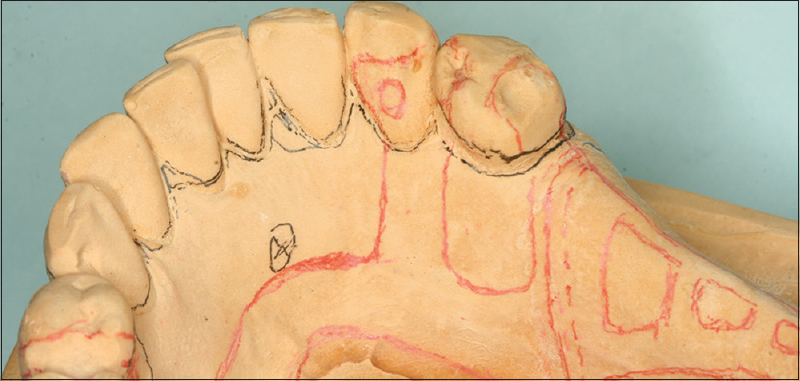 | Figure 1: Working cast is fabricated, and the design of framework is designed for the technician to make wax pattern
Click here to view |
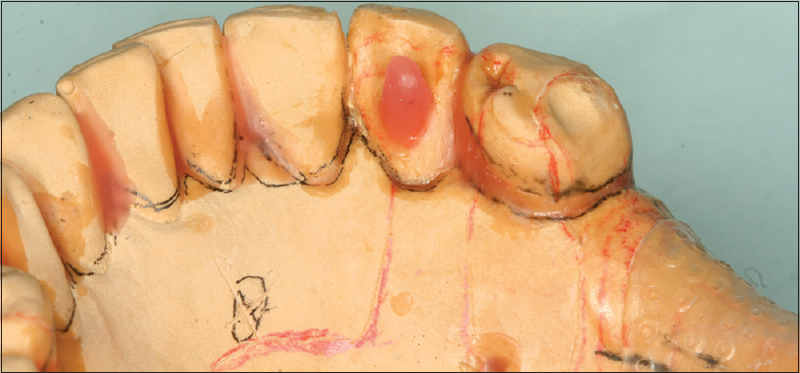 | Figure 2: The rest seat is waxed up for the supportive rest seat on the lingual surface of the working cast in the laboratory room
Click here to view |
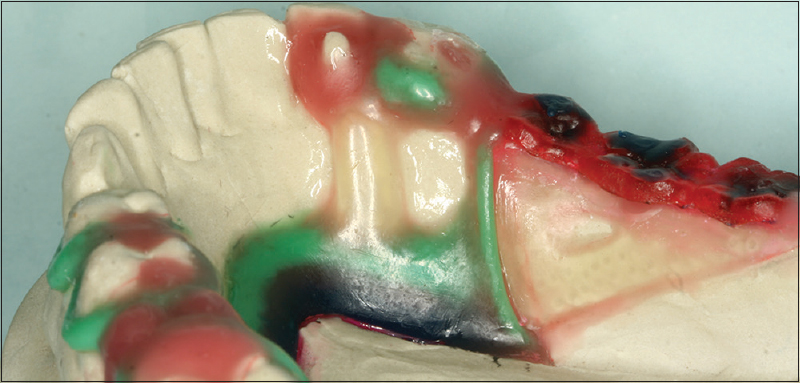 | Figure 3: Wax pattern is made for a removable partial denture framework with the cingulum rest with small hole on the refractory cast
Click here to view |
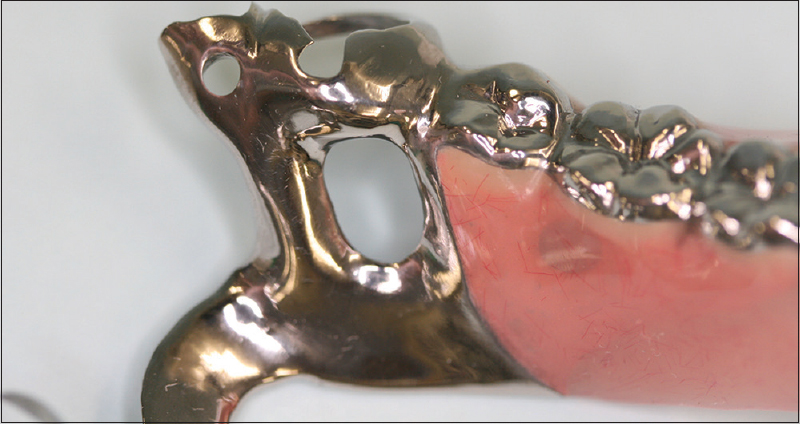 | Figure 4: The removable partial denture is completed by casting, resin polymerization, and polishing
Click here to view |
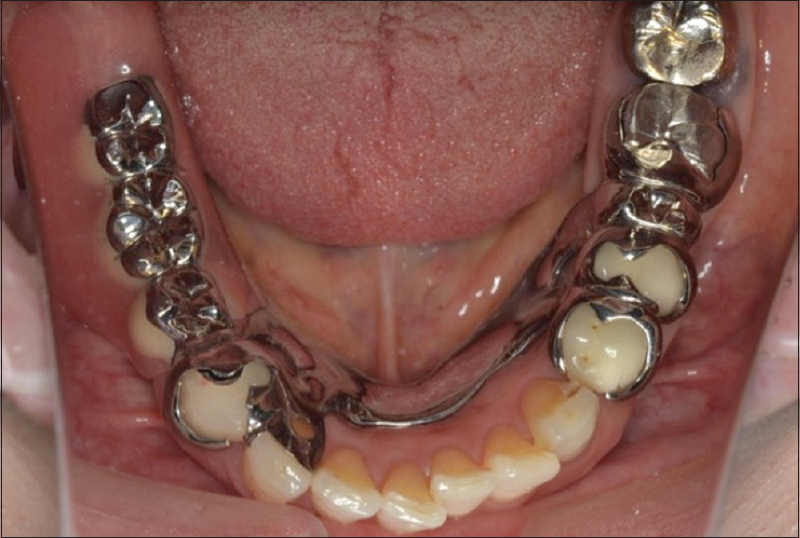 | Figure 5: Removable partial denture with titanium occlusion is completed and placed into the mouth
Click here to view |
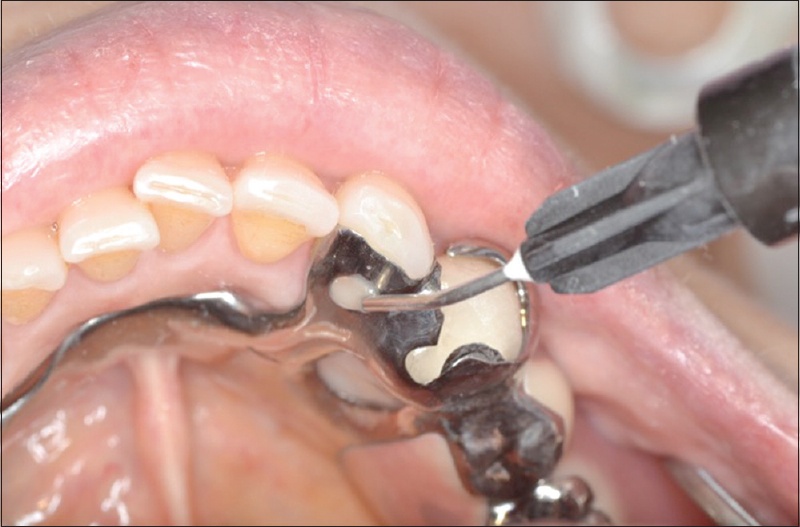 | Figure 6: Bonded-composite resin is injected through the hole into the space between the lingual surface of abutment tooth and the inner surface of the lingual rest and polymerized by visible light under occlusal force
Click here to view |
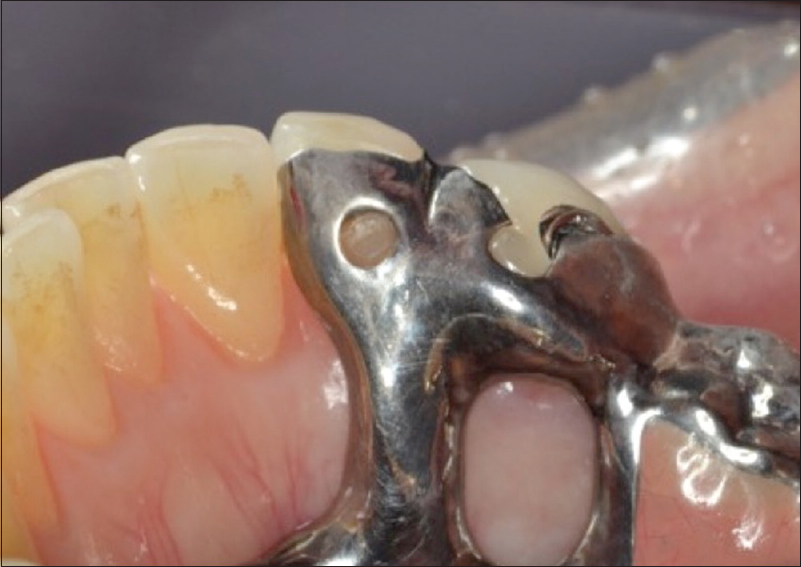 | Figure 7: The composite resin is polymerized using visible light under occlusal force
Click here to view |
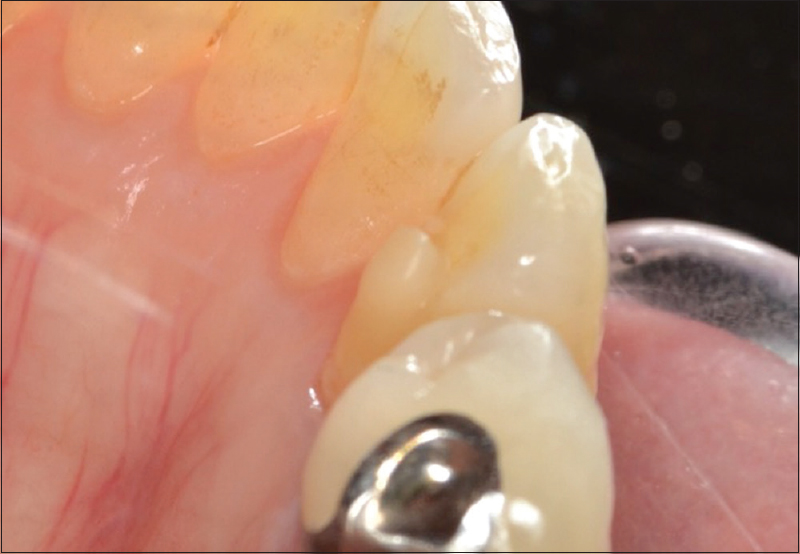 | Figure 8: Removable partial denture is removed from the mouth and the bonded resin of the cingulum rest seat is lightly polished
Click here to view |
| Conclusion | |  |
Adequate rest seats can be formed on the working cast using wax and a cast titanium RPD framework with the appropriate space for a properly designed cingulum rest seat can be fabricated. Using bonded composite resin, an appropriate cingulum rest seat can be affixed post-RPD delivery without previous mouth preparation.
Financial support and sponsorship
Nil.
Conflicts of interest
There are no conflicts of interest.
| References | |  |
| 1. | Likeman PR, Juszczyk AS. An examination of cingulum rest seats in incisor and canine teeth. Eur J Prosthodont Restor Dent 1993;1:165-71.  |
| 2. | Carr AB, Brown DT. McCracken's Removable Partial Prosthodontics. 12 th ed. St. Louis, MO: Elsevier; 2011. p. 56-66.  |
| 3. | Seto BG, Caputo AA. Bond strength of etched-metal resin-bonded cingulum rest seats. J Prosthet Dent 1987;58:458-62.  |
| 4. | Shimizu H, Takahashi Y, McKinney T. Resin-bonded castings with a cingulum rest seat and a guide plane for a removable partial denture: A case report. Quintessence Int 2008;39:e11-4.  |
| 5. | Janus CE, Unger JW, Crabtree DG, McCasland JP. A retrospective clinical study of resin-bonded cingulum rest seats. J Prosthodont 1996;5:91-4.  |
| 6. | Zanetti AL, Mengar MA, Novelli MD, Laganá DC. Thickness of the remaining enamel after the preparation of cingulum rest seats on maxillary canines. J Prosthet Dent 1998;80:319-22.  |
| 7. | Maeda Y, Kinoshita Y, Satho H, Yang TC. Influence of bonded composite resin cingulum rest seats on abutment tooth periodontal tissues: A longitudinal prospective study. Int J Prosthodont 2008;21:37-9.  |
[Figure 1], [Figure 2], [Figure 3], [Figure 4], [Figure 5], [Figure 6], [Figure 7], [Figure 8]
|